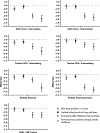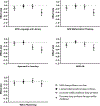Longitudinal sleep problem trajectories are associated with multiple impairments in child well-being
- PMID: 32713013
- PMCID: PMC7530051
- DOI: 10.1111/jcpp.13303
Longitudinal sleep problem trajectories are associated with multiple impairments in child well-being
Abstract
Background: This study examined whether distinct sleep problem trajectories from infancy through middle childhood were associated with multiple aspects of child well-being at ages 10-11 years.
Methods: Data were from the first six waves of the Longitudinal Study of Australian Children - Birth Cohort (5,107 children recruited at birth). Caregivers reported on child sleep problems at each time point. A combination of caregiver-reported, teacher-reported and child-completed tasks were used to index child well-being outcomes at ages 10-11 years including emotional/behavioural functioning (internalizing and externalizing symptoms; self-control), health-related quality of life, cognitive skills and academic achievement.
Results: Latent class analysis identified five distinct sleep problem trajectories over time: persistent sleep problems through middle childhood (7.7% of the sample), limited infant/preschool sleep problems (9.0%), increased middle childhood sleep problems (17.0%), mild sleep problems over time (14.4%) and no sleep problems (51.9%). Compared to those with no sleep problems, children with persistent sleep problems had the greatest impairments across all outcomes except cognitive skills (perceptual reasoning), with moderate to large effect sizes. Children with increased middle childhood sleep problems similarly experienced greater internalizing and externalizing symptoms and worse quality of life, but few academic impairments. Both the limited infant/preschool sleep problems and mild increases over time trajectories also showed internalizing concerns and worse caregiver-reported quality of life, although effects were smaller than the other sleep trajectories.
Conclusions: The linkages between sleep problems and negative child outcomes across domains underscore the importance of early identification and targeted intervention to address sleep problems and promote child well-being.
Keywords: Academic; cognitive; longitudinal studies; quality of life; sleep; well-being.
© 2020 Association for Child and Adolescent Mental Health.
Conflict of interest statement
Conflict of interest statement: No conflicts declared.
Figures



Similar articles
-
Sleep Problem Trajectories and Cumulative Socio-Ecological Risks: Birth to School-Age.J Pediatr. 2019 Dec;215:229-237.e4. doi: 10.1016/j.jpeds.2019.07.055. Epub 2019 Sep 26. J Pediatr. 2019. PMID: 31564429 Free PMC article.
-
Sleep problems, internalizing and externalizing symptoms, and domains of health-related quality of life: bidirectional associations from early childhood to early adolescence.Sleep. 2021 Jan 21;44(1):zsaa139. doi: 10.1093/sleep/zsaa139. Sleep. 2021. PMID: 32691073 Free PMC article.
-
Bidirectional Associations Between Child Sleep Problems and Internalizing and Externalizing Difficulties From Preschool to Early Adolescence.JAMA Pediatr. 2018 Feb 5;172(2):e174363. doi: 10.1001/jamapediatrics.2017.4363. Epub 2018 Feb 5. JAMA Pediatr. 2018. PMID: 29204659 Free PMC article.
-
Group-based sleep trajectories in children and adolescents: A systematic review.Sleep Med Rev. 2024 Jun;75:101916. doi: 10.1016/j.smrv.2024.101916. Epub 2024 Feb 29. Sleep Med Rev. 2024. PMID: 38461678
-
Childhood sleep: physical, cognitive, and behavioral consequences and implications.World J Pediatr. 2024 Feb;20(2):122-132. doi: 10.1007/s12519-022-00647-w. Epub 2022 Nov 23. World J Pediatr. 2024. PMID: 36418660 Free PMC article. Review.
Cited by
-
Fears and Worries at Nighttime in Young Children: Development and Psychometric Validation of a Parent-Report Measure (FAWN-YC).Child Psychiatry Hum Dev. 2024 Sep 16. doi: 10.1007/s10578-024-01758-3. Online ahead of print. Child Psychiatry Hum Dev. 2024. PMID: 39283504
-
A Longitudinal Approach to the Relationships Among Sleep, Behavioral Adjustment, and Maternal Depression in Preschoolers.Front Psychol. 2022 Apr 13;13:819657. doi: 10.3389/fpsyg.2022.819657. eCollection 2022. Front Psychol. 2022. PMID: 35496247 Free PMC article.
-
Sleep Problems in Children with ASD and Gene Disrupting Mutations.J Genet Psychol. 2021 Sep-Oct;182(5):317-334. doi: 10.1080/00221325.2021.1922869. Epub 2021 May 17. J Genet Psychol. 2021. PMID: 33998396 Free PMC article.
-
Correlates of a caregiver-reported child sleep problem and variation by community disadvantage.Sleep Med. 2022 Feb;90:83-90. doi: 10.1016/j.sleep.2022.01.009. Epub 2022 Jan 13. Sleep Med. 2022. PMID: 35123150 Free PMC article.
-
Associations between demographic and parental factors and infant sleep characteristics.Sleep Biol Rhythms. 2022 Dec 17;21(2):221-232. doi: 10.1007/s41105-022-00438-w. eCollection 2023 Apr. Sleep Biol Rhythms. 2022. PMID: 38469278 Free PMC article.
References
-
- Alfano CA (2018). (Re) conceptualizing sleep among children with anxiety disorders: Where to next? Clinical Child and Family Psychology Review, 21, 482–499. - PubMed
-
- American Academy of Sleep Medicine (2014). International classification of sleep disorders—third edition (ICSD-3). Darien, IL: American Academy of Sleep Medicine.
-
- Astill RG, Van der Heijden KB, Van Ijzendoorn MH, & Van Someren EJ (2012). Sleep, cognition, and behavioral problems in school-age children: A century of research meta-analyzed. Psychological Bulletin, 138, 1109–1138. - PubMed
-
- Australian Curriculum, Assessment and Reporting Authority (2018). National Assessment Program Test Development. Available from: https://www.nap.edu.au/about/test-development [last accessed 11 May 2020].
-
- Australian Government Department of Families, Housing, Community Services and Indigenous Affairs (2011). Growing up in Ausralia: The Longitudinal Study of Australian Children 2009–10 Annual Report. Retrieved from Australia.

